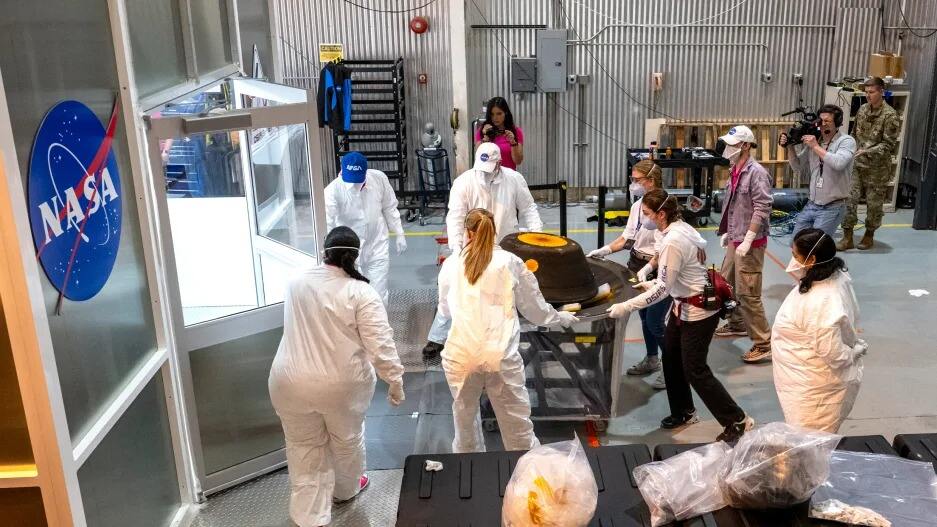- | 9:00 am
NASA had a very busy—and productive—2023
This year, space’s power to inspire and drive innovation reached all corners of the world.

It’s been a busy year for NASA—full of asteroid missions and collaborations with industry, other national space agencies, and the U.S. military. This year, space’s power to inspire and drive innovation reached all corners of the world.
Here’s our rundown of NASA’s greatest achievements of 2023.
OSIRIS-REX RETURNS
It had been an incredibly long journey for the OSIRIS-REx capsule by the time it landed in the Utah desert in September. The asteroid probe launched in 2016 on a two-year journey to carbon-rich asteroid Bennu with an ambitious mission objective to bring back a hefty sample. OSIRIS-REx did its job well, scooping up ~250 g of extraterrestrial rock and dust before jetting off home—the largest asteroid sample ever returned to Earth.
“The OSIRIS-REx sample is the biggest carbon-rich asteroid sample ever delivered to Earth and will help scientists investigate the origins of life on our own planet for generations to come,” NASA chief Bill Nelson said in October when the capsule was opened and its contents were revealed.
After dropping off its Bennu sample, the OSIRIS-REx spacecraft altered course and earned a new name: OSIRIS-APEX. The old dog is now en route to the asteroid Apophis, which it will study for ~18 months.
NUCLEAR NEWS
NASA kicked off 2023 on a high note, announcing a groundbreaking partnership with the Defense Advanced Research Projects Agency (DARPA) in January to kick-start the U.S.’s dormant nuclear thermal propulsion program for spaceflight after a 50-year hiatus from pursuing the technology.
- Nuclear fission engines have sat in a gray area under the 1967 Outer Space Treaty, but if developed safely, they could drastically reduce the travel time to send humans to Mars.
- “If we have swifter trips for humans, they are safer trips,” NASA Deputy Administrator Pam Melroy said at the time.
A few months later, NASA and DARPA put their money where their mouth is, awarding Lockheed Martin a $499M contract to build a nuclear fission-powered rocket and fly a demo as early as 2026. And now we wait . . .
PSYCHE LIFTS OFF
Bennu wasn’t the only asteroid on NASA’s mind this year. After months of delays and uncertainty, the agency finally sent the Psyche probe on its route to the eponymous metal-rich asteroid aboard a Falcon Heavy in October. The target asteroid’s high metal content is unique among the asteroids that Earthly visitors have approached, and the probe aims to increase our understanding of this type of object. Psyche is expected to arrive at its target in 2029.
LEADING THE WAY
NASA’s contributions to exploration may be best measured by how much it is able to spur and fund the development of novel technologies in the commercial sector. This year, agency programs led to major progress in industry.
- The Commercial Lunar Payload Services (CLPS) program is in full swing, with many of the awardees gearing up to their first lunar lander launches (say that five times fast). The first two are slated for launch in January, with Astrobotic’s Peregrine lander targeting the 8th and Intuitive Machines’ Nova-C targeting the 12th.
- The Commercial LEO Destinations (CLD) program is also picking up speed. A number of companies building commercial space stations to replace the ISS notched new milestones and secured new collaborators in 2023.
- Commercial providers are now forging the path for human spaceflight. Two SpaceX crew missions flew to the ISS this year, along with the Ax-2 private astronaut mission through Axiom Space. Boeing also sent its long-awaited Starliner capsule to the station for the first time in May.
A HAPPY ANNIVERSARY
Last but not least, we couldn’t let a roundup of NASA’s greatest achievements go by without wishing a very happy (and only a little belated) birthday to the ISS, which celebrated 25 years of operations this year. As NASA begins to plot out its strategy for the end of the historic station’s life, we can’t help but feel a little nostalgic.
This story originally appeared on Payload and is republished here with permission.







































